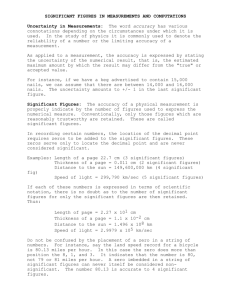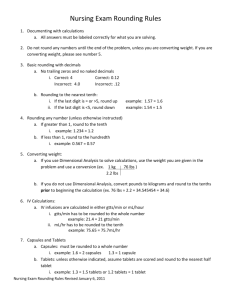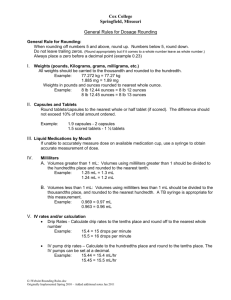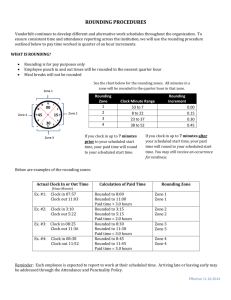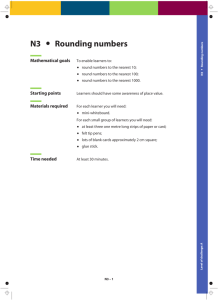IS 2 (1960): Rules for Rounding off Numerical Values
advertisement
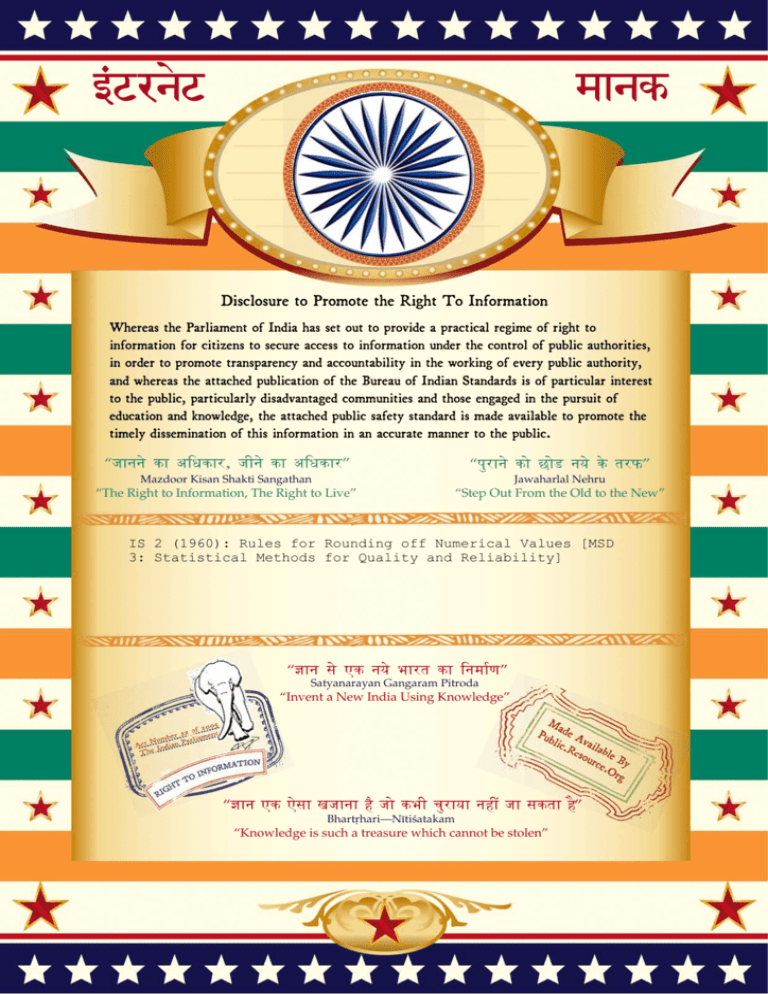
इंटरनेट
मानक
Disclosure to Promote the Right To Information
Whereas the Parliament of India has set out to provide a practical regime of right to
information for citizens to secure access to information under the control of public authorities,
in order to promote transparency and accountability in the working of every public authority,
and whereas the attached publication of the Bureau of Indian Standards is of particular interest
to the public, particularly disadvantaged communities and those engaged in the pursuit of
education and knowledge, the attached public safety standard is made available to promote the
timely dissemination of this information in an accurate manner to the public.
“जान1 का अ+धकार, जी1 का अ+धकार”
“प0रा1 को छोड न' 5 तरफ”
“The Right to Information, The Right to Live”
“Step Out From the Old to the New”
Mazdoor Kisan Shakti Sangathan
Jawaharlal Nehru
IS 2 (1960): Rules for Rounding off Numerical Values [MSD
3: Statistical Methods for Quality and Reliability]
“!ान $ एक न' भारत का +नम-ण”
Satyanarayan Gangaram Pitroda
“Invent a New India Using Knowledge”
“!ान एक ऐसा खजाना > जो कभी च0राया नहB जा सकता ह”
है”
ह
Bhartṛhari—Nītiśatakam
“Knowledge is such a treasure which cannot be stolen”
IS: 2 -1960
(Reaffirmed 2000)
Indian Standard
REAFFi"iviED
"'In"'J
LiJ
RULES FOR ROUNDING OFF
NUMERICAL VALUES
(Revised)
Sixteenth Reprint JULY 2007
(Including Amendment Nos. I. 2 & 3)
UDC 511.135.6
© Copyright 1960
BUREAU OF INDIAN STANDARDS
MANAK BHAVAN. 9 BAHADUR SHAH ZAFAR MARG
NEW DELHI 110002
Gr3
September 1960
Indian Standard
RULES FOR ROUNDING OFF
NUMERICAL VALUES
(Revised)
Engineering Standards Sectional Committee, EDG I
Chairman
Hit K. S.
KRISHNAN
Council of Scientific
New Delhi
&
Industrial
Research,
Memb'r!
Smu PREM PRAKASH ( Altrmate to
Dr K. S. Krishnan)
Research, Design & Standardization Organizalrun
( Ministry of Railways)
Central Board of Irrigation & Power, New Delhi
Smu BAI.ESIIWAR NATIl
Directorate General of Observatories (Ministry of
DEPUTY DIRI!.CTOR GENERAL OF
Transport & Communications), New Delhi
OIlSF.RVATORIES
Engineering Research Department, Oovernmcni of
DnU:'CTOR
Andhra Pradesh
Institution of Engineers ( India), Calcutta
SURI S. B. J08m
Indian Engineering Association, Calcutta
SUR I R. N. KAPUR
Indian Institute of Science, Bangalore
DR R. S. KRI8uNAN
SHRI S. R. MElIRA
Couneil of Scientific &
Industrial Researchs
New Delhi
5mu S. N. l>.tl1KERJ1
Government Test House, Calcutta
Smu K. D. BnATTAcHARJI:E ( Alternate)
DR B. R. NIJIIAWAN
Council of Scientific &
Industrial Research,
New Delhi
SURI V. R. RAOHAVAN
Central Watt-r & Power Commission, Nf'w Delhi
BR.o J. R. SA.MIOI'f
Controller of Development (Armaments) (Ministry
of Defeaee )
A5SISTANT DIRECTOR
J,T.COL R.JANAR.oHANAM (Altel'1lall)
( Ctnttirrs.t1 011 page 2 )
BlJREAU OF INDIAN STANDARDS
MANAK BHAVAN. 9 UAIIADUR SHAH ZAFAR MARO
NEW DEUU 110002
IS: 2 ·1960
( (.&lIli,l/Ir" from flllgt: J )
JIembers
R. '\;. SARM.\
Uin:ctoralt: Gl~nl'ral uf Supplics at Dispoaals
( Ministry of Works, Houllng at Supply)
SHRIJ. M. SINHA
Engincering Association of India, Calcutta
SJlRIJ. M. TIU!.OAN
Ministry of Transport at Communications (Roads
Wing)
SURI T. N. ~HARO""iA ( .Ullmate)
LT-GBN H. Wn.I.IA)IS
Council (If Scientific &
IndultriaIRc.n·an:1i,
New Delhi
DII LAT. C. VERMAN (J:.~io)
Director, lSI
.SURI J. P. MElIllO,.R.",
Deputy Director ( Engg ), IS r
SIIRI
( .~llernQlIl )
S,crrtari,·s
Dit A, K. GUPTA
:-)1111.1 B. N. StKl'lli
Assistant Director ( Stal ), lSI
Extra Assistant Director ( Stat), lSI
2
AMENDMENT NO. 1 FEBRUARY 1997
TO
IS 2: 1960 RULES FOR ROUNDING ors
NUMERICAI.. VALVES
( Revised)
(Page 3, clause 0.4 ) - Insert the following after first entry:
IS 1890 (PARTO ) : 1995/1S0 31-0: 1992 QUANTI11FS AND UNITS: PART 0
GENFRAL PRINCIPLES ( FIRST REVISION)
( Page 8, clause 3.3 ) -- Insert the foJlowing new clause after 3.3:
"3.4 The rules given in 3.1, 3.2 and 3.3 should be used only if no specific
criteria for the selection ()fthl~ rounded number have to be taken into account, In
cases, where specific limit ('Maximum' or 'Minimum') has been stipulated or
where specifically mentioned in the requirement, it may he advisable always to
round in one direction.
Examples:
I)
The requirement of leakage current for domestic electrical appliances
is 210 !-tA (rms) maximum,
The rounding may be done in one direction. For example, if a test result
is obtained as 210.], it will be rounded up and reported as 211 !-tA.
2)
The requirement for cyanide (as eN) for drinking water is specified as
maximum beyond which drinking water shall be considered
toxic.
O'<~5 IllgIJ,
The rounding may be done in one direction. For example, if 8 test result
is obtained as 0.051 mg/l, it will he rounded up and reported as
0.06 mg/l.
3)
The requirement for minimum thickness of the body of LPG cylinder is
2.4 mm.
The rounding may be done in one direction. For example, if It le-st result
is obtained as 2.39 mill, it will be rounded down and reported as 2.3
10m.
Amend No.1 to IS Z: l'60
4)
The requirement for Impact-Absorption for Protective Helmets for
Motorcycle Riders is:
'The conditioned helmet tested shall meet the requirements, when
tbe resultant acceleration (RMS value of acceleration measured
along tbree directions) measured at the centre of gr!vity of tbe
beadform shall be s 150 go (where go ::: 9.81 m/sec) for any 5
milliseconds continuously and at no time exceeds 300 go.'
The rounding may be done ill one direction. If a test result is obtained as
150.1 go, it will be rounded up and reported as 151 go."
(MSD 1 )
2
AMENDMENT NO.2 OCTOBER 1997
TO
IS 2: 1960 RULES FOR ROUNDING OFF
NUMERICAL VALUES
( Reyised)
(Amendment No.1, February 1997, Page I, clause 3.4, line 4 ) tbe word 'always' appearing after the word 'advisablc'.
(MSD 1)
Delete
AMENDMENT NO.3 AUGUST 2000
TO
IS 2: 1960 RULES FOR ROUNDING OFF
NUMERICAL VALVES
( Revised)
( Page 5, clause 3.1, para 1 ) following:
Substitute the first sentence for the
'In case the fineness of rounding is unity in the last place retained, the following
rules (except in 3.4) shall be followed:'
(Amendment No.1, February 1997, clause 3.4 ) sentence for the following:
Substitute the second
'In all cases, where safety requirements or prescribed limits have to be respected,
rounding off should be done in one direction only.'
(Amendment No.1, February 1997, clause 3.4 ) given under this clause.
Delete all the exaUlplea
(Amendment No.2, October 1997) - Delete this amendment.
(MSD3 )
IS: 2-1960
Indian Standard
RULES FOR ROUNDING OFF
NUMERICAL VALUES
( Revised)
o.
FOREWORD
0.1 This Indian Standard (Revised) was adopted by the Indian Standards
Institution on 27 July 1960, after the draft finalized by the Engineering
Standards Sectional Committee had been approved by the Engineering
Division Council.
0.2 To round off a value is to retain a certain number of figures, counted
jrom the lift, and drop the others so as to give a more rational form to the
value. As the result of a test or of a calculation is generally rounded off
for the purpose ofreporting or for drafting specifications, it is necessary to
prescribe rules for ' rounding off' numerical values as also for deciding on
• the number of figures' to be retained.
0.3 This standard was originally issued in 1949 with a view to promoting
the adoption of a uniform procedure in rounding off numerical values.:
However, the rules given referred only to unit fineness of rounding ( su 2.3 )
and in course of years the need was felt to prescribe rules for rounding
off numerical values to fineness of rounding other than unity. Moreover,
it was also felt that the discussion on the number of figures to be retained as
given in the earlier version required further elucidation. The present revision
is expected to fulfil these needs.
0.4 In preparing this standard, reference has been made to the following:
IS: 787-1956 GuIDE FOR INTBR-CONVBlUION 011' VALva. FROM ONE
SYSTEM OF UNITS TO ANOTHER. Indian Standards Institution.
B.S. 1957: 1953 PRUBNTATION OF NUKltlUCAL VALUES ( FINBNESS OP
EXPREISION; ROUNDINO 011' NUMBERS). British Standards Institution.
AMERICAN STANDARD Z 25.1-1940 RULES FOR ROUNDING OFF
NUMltRICAL VALUES. American Standard. Auociation.
ASTM DUIGNATION: E 29-50 RECO.....NDED PRAOTICB FOR DElIONATINO SIONlflCANT PUCU IN SPEOI.,BD VALuas. American
Society for 'resting and Materials.
JAKBS W. SoAllBOROUOH. Numerical Mathematical AnaJ)'IiJ. Baltimore. The John Hopkins Preas, 1955.
3
IS: 2 .1960
1. SCOPE
1.1 This standard prescribes rules for rounding off numerical. values for the
purpose of reporting results of a test, an analysis. a measurement or a calculation. and thus assisting in drafting specifications. It also makes recommendations as to the number of figures that should be retained in course
of computation,
2. TERMINOLOGY
2.0 For the purpose of this standard. the following definitions shall apply.
2.1 Nu.ber or Dedm." Places - A value is said to have as many
decimal places as there are number of figures in the value, counting from the
first figure after the decimal point and ending with the last figure on the right.
&tampllS:
Valu,
DlCimDl PltUu
0'02950
21-0295
2 000'000 00 I
291'00
10'32 X 101
( SII Note I )
5
4-
6
2
2
NOTa I-For the PW'P'1e of this It'ndard, the expression 10'32 x 101 should be
taken to conaist of two partl. the value proper which is 10'32 aDd the unit of Vlptcuion
for the value, 10.,
2.2 NlUDber or SigaiaeaDt Figures - A value is said to have as many
significant figures as there are number of significant digits (,tI Note 2)
in the value. counting from the left-moat nOlN,tTO digit and ending with the
right-moat digit in the value.
Exampl,s:
Valu,
Signijieant Figures
0'029500
0'0295
10'0295
2000'000 001
5677'0
567700
56'77 X lOt
.' 0056'770
3900
(St' Note 3 )
5
3
6
10
5
6
4
5
4
NOTB 2 - Any of the dititl, 1. 2, 3
9 occurrin, in a value than be a ailni.
digit(I); and zero 'ball be • Iigni6caDt digit only whrn it is preceded by lOme
fiCIIDt
4
IS: 2 -1960
other digit ( excepting zeros) on its left. When appearing in the power of 10 to indicate
the magnitude of the unit in the expression of a value, zero shan nOI be a significant
digit.
NOTa 3 - With a view to removing any ambiguity regarding the significance of the
zeros at the end in a value like 3 900, it would be a"vHys desirable to write the value in
the power-often notation. For example, 3 gOO may be written as 3'9 x 103,3'90 X 103
or 3'900 X 103 depending upon the last figurc(s) in the value to which it is desired to
impart significancl".
2.3 FIDeDe•• of ROIIDcUll. - The unit to which a value is rounded off.
For example, a value may be rounded to the nearest 0'00001,0'0002,
0'000 5, 0'001, 0'002 5, 0'005, 0'01, 0'07, I, 2'5, lO, 20, 50, 100 or any
other unit depending on the fineness desired,
3. RULES FOR ROUNDING
3.0 The rule usually followed in rounding off a value to unit fineness of
rounding is to keep unchanged the last figure retained when the figure next
bcyond is less than.') and to increase by I the last figure retained when the
figure ncxt beyond is more than 5. There is diversity of practice when the
figure next beyond the last figure retained is 5. III such cases, some cornputers 'round up', that is, increase hy I, the last figure retained: others
, round down " that is, discard everything beyond the last figure retained,
Obviously, if the retained value is always' rounded up , or always' rounded down', the sum and the average of a series of values so rounded will
be larger or smaller than the corresponding sum or average of the unrounded values. , However, if rounding oft" is carried out in accordance with the
rules slated in 3.1 in one step (see 3.3), the slim and the average of the
rounded values would be more nearly correct than in the previous caSC5
( see Appendix A ).
3.1 ROllllcUDg Oft'to UDit Finellea8 - In case the fineness of rounding is
unity in the last place retained, the following rules shall be followed:
. Rule I -- When the figure next beyond the last figure Or place to
be retained is less than 5, the figure in the last place retained shall he
left unchanged.
RuLe II···- Wht~n the figure next beyond the last figure or place
to be retained is more than 5 or is 5 followed by any figures other
than zeros, the figure in the last place retained shall be increased
by l.
Rule 11/--- When the figure next beyond the last figure or place
to be retained is 5 alone or 5 followed by zeros only, the figure in the
last place retained shall be (a) increased by 1 if it is odd and (b) left
unchanged if even (zero would be regarded as an even number Ior
this purpose).
5
bh 2·1960
Some examples illustrating the application of Rules I to III are given
in Table I.
TABLE I
EXA.MPLES OF ROUNDING OFF VA.LVES TO UNIT FINENESS
FnrENUI
VAunt
Olr. -_
ROUNDING
------A
___ .
1
0·1
r---.A.~
Rounded
Value
7·260414·725
3·4-55
13·545001
8·725
19·205
0·5499
0-6501
00()49 50
7
15
3
14-
9
19
1
1
0
Rule
•Rounded
,
~
Rule
Value
I
II
I
7.3
)4·7
Ii
I
3·5
n
II
II
I
II
13·5
8·7
19·2
0·5
0·7
0·0
1
I
II
I
0·01
r----.A.---~
Rounded
Value
Rule
7·26
1
III (b)
14·72
III(a)
3·46
13·55
8·72
19·20
0.55
0.65
0·05
I
I
II
1
11
III (b)
III (b)
II
1
II
0·001
r-----A...----'"
Rounded Rule
Value
7·260
)4.·725
3·455
13·545
8·725
19·205
0·550
0·650
0·050
I
I
II
I
111 (a)
3.1.1 The rules for rounding laid down in 3.1 may be extended to apply'
when the fineness of rounding is 0'10, 10, 100, I 000, etc. For example,
2'43 when rounded to fineness 0'10 becomes 2'40. Similarly, 712 and 715
when rounded to the fineness 10 become 710 and 720 respectively,
3.2 Roaadi...g Oft" to Fi...e...ess Other than Unity-· In case the fineness
of rounding is not unity, but, say, it is n, the given value shall be rounded
off according to the following rule:
Rule IV - When rounding to a fineness n, other than unity, the
given value shall be divided by n, The quotient shall be rounded off to
the nearest whole number in accordance with the rules laid down
in 3.1 for unit fineness of rounding. The number so obtained, that
is, the rounded quotient, shall then. be multiplied by n to get the final
rounded value.
Some examples illustrating the application of Rule IV are given in
Table II.
NOTE 4 - The ruJea for rounding oft'a value to any linenf'SS of rounding, II, may allO
be alated in line \\itb thOle for unitfineneas of rounding (
3.1 ) as follows:
&,.
Divide the given value by II 10 that an iotqJral quotient and a rC'mainder are
obtained. Round oft'tbe value in the following manner:
a) Irthe remainder islf:l!l tban 11/2, the value shall be rounded down aueh that
the rounded value is an integral multiple of II.
6
IS 12 -1960
b) If the remainder is greater than n/2, the value shall be rounded up sueh
that the rounded value is an integral multiple of n.
e) If the remainder is exactly equal to n/2, that rounded value shall be cbOlC.D
which is an integral multiple of 2n.
TABLE D
VALUE
(1)
1.6478
2-70
2·4968
1·75
0·68721
0·875
325
1025
EXAMPLES OF ROUNDING OFF VALUES TO FINENESS
OTHER THAN UNIT
FINENESS OF
ROUNDINO, n
QUOTIENT
ROUNDIill
QUOTIENT
FINAL ROUNDKD
VALUE
(2)
(3) =( I)/(2)
(4)
(5)=(2) X (4)
0·2
0·2
0·3
0·5
0·07
0·07
50
50
8·239
13·3
8·3227
3·5
9·8173
12-5
6·5
20·5
8
14
8
4
10
12
6
20
1.6
2·8
204·
2·0
0·70
0·84
3 X 102
10 x 102
3.2.1 Fineness of rounding other than 2 and 5 is seldom called for In
practice. For these cases, the rules for rounding may be stated in
simpler form as follows:
a) Rounding off to fineness 50, 5, 0'5, 0'05, 0'005, etc.
RuLe V - When rounding to 5 units, the given value shall be
doubled and rounded off to twice the required fineness of rounding in
accordance with 3.1.1. The value thus obtained shall be halved to
get the final rounded value.
For example, in rounding off 975 to the nearest 50, 975 is doubled
giving I 950 which becomes 2000 when rounded off to the nearest 100; when
2 000 is divided by 2, the resulting number I 000 is the rounded value of
975.
b) Rounding off to fineness 20,2,0'2,0'02,0'002, etc.
Rule VJ -- When founding to 2 units, the given value shall be
halved and rounded off to half the required fineness of rounding in
accordance with 3.1. The value thus obtained shall then he doubled
to get the final rounded value.
FOf example, in rounding off 2'70 to the nearest 0-2, 2'70 is halved
giving 1'35 which becomes 1'4 when rounded off to the nearest 0'1; when
1'4 is doubled, the resulting number 2'8 is the founded value.
7
IS: 2 -1960
3.3 Successive Rouading - The final rounded value shall be obtained
from the most precise value available in ant" step only and not from a series
of successive roundings. For example, the value 0'549 9, when rounded to
one significant figure, shall be written as 0'5 and not as 0'6 which is obtained
as a result of successive roundings to 0'550,0-55, and 0'6. It is obvious that
the most precise value available is nearer to 0'5 and not to 0-6 and that
the error involved is less in the former case, Similarly, 0'650 I shall be
rounded off to O'7 in one step and not successively to 0'650, 0'65 and 0'6,
since the most precise value available here is nearer to 0'7 than to 0'6
( see also Table I ).
NOTE 5 - In those cases where a final rounded value terminates with 5 and it is
intended to usc it in further computation, it may be helpful to use a ,+, or '-' sign after
the Iinal 5 to indicate whether a subsequent rounding should be up or down. Thus
3'214 7 may be written as 3-215- when rounded to :1 fineness of rounding 0'001. If
further rounding to three significanr figures is desired, this number would be rounded
down and written as 3-21 which is in error by less than hal f a unit in the last place; ,
other.....ise, rounding of 3-215 would have yielded 3'22 which is in error by mort than half
a unit in the last place. Similarly, :-1-:.105 4 could be written as 3'205+ when rounded
to 4 significant figures. Further rounding to 3 significant figures would yield the
value as 3-21.
In case the final 5 is obtained exactly, it would he indicated by leaving the 5 as such
without using '+' or '-' sign. In subsequent rounding the 5 would then be treated in
accordance with Rule Ill.
4. NUMBER OF FIGURES TO BE RETAINED
4.0 Pertinent to the application of the rules for rounding off is the underlying decision as to the number of figures that should be retained in a given
problem. The original values requiring to be rounded off may arise as a
result of a test, an analysis or a measurement, in other words, experimental
results, or they may arise from computations involving several steps.
4.1 Experilnental Results - The number of figures to he retained in an
experimental result, either for the purpose of reporting or for guiding the
formulation of specifications will depend on the significance of the figures
in the value. This aspect has been discussed in detail under 4 of IS: 7871956 to which reference may be made for obtaining helpful guidance.
4.2 Computations -In computations involving values of different
accuracies, the problem as to how many figures should he retained at various
steps assumes a special significance as it would affect the accuracy of the
final result. The rounding off error will, in fact, be injected into computation
every time an arithmetical operation is performed. It is, therefore, necessary
to carry out the 'Computation in such a manner as would obtain accurate
results consistent with the accuracy of the data in hand.
4.2.1 While it is not possible to prescribe details which may be followed
in computations of various types, certain basic rules may be recommended
8
IS: 2·1960
for single arithmetical operations which, when followed, will save labour
and at the same time enable accuracy of original data to be normally
maintained in the final answers.
4.2.2 As a guide to the number of places or figures to be retained in the
calculations involving arithmetical operations with rounded or approximate
values, the following procedures are recommended:
a) Addition - The more accurate values shall be rounded off so as to
retain one more place than the last significant figure in the least
accurate value. The resulting sum shall then be rounded off to
the last significant place in the least accurate value.
b) Subtraction -- The more accurate value ( of the two given values)
shall be rounded off, before subtraction, to the same place as the
last significant figure in less accurate value; and the result shall be
reported as such (see also Note 6 ).
c) Multiplicatiofl and Dioision -- The number of signijicant figures
retained in the more accurate values shall be kept one more than
that in the least accurate value. The result shall then be rouuded
off to the same number of significant figures as in the least accurate
value.
d) When a long computation is carried out in several steps, the intermediate results shall be properly rounded at the end of each step
so as to avoid the accumulation of rounding errors in such cases.
I t is recommended that, at the end of each step, one more significant figure may be retained than is required under (a), (b) and
(c) (see also Note 7).
NOTr. 6 --- Tile loss of the significant figures in the" subtraction of two nearly equal
values is the Krratcst soirce of inaccuracy in most computations, and it forms the
weakest link ill a chain computation where it occurs. Thus, if the values O'16~1 52 and
()'168 71 arc each correct to five significant figures, their difference O'O()O 81. which has
only two significant figures. is quite lik.e1y to introduce inaccuracy in subsequent
computation,
If, however, the diffcrcnct: of two values is desired to be correct 10 k ,i~niljcant figures
and if it is known beforehand that the lirst m significant figures at the left will disappear
by subtraction, then the number of significant figures to hI" retained ill earh of thrvalues shall be m + k ( se« Example -1).
Non; 7 - To ensure a greater degree of accuracy in th.. computations. it is also
desirable to avoid or defer . I long as possible certain approximation operations like
that of the division or square root. For example, in the determination of sucrose by
(fa _1..1)
~OWl
may be better evaluated by taking
It'.
VI
Vl
(it Vl - ft V:! )(1411 1'1 I'. which would defer the division
volumetric method, the expression
iu calculational form as 20Wl
until the last operation or the calculation.
9
IS: 2-1960
4.2.3 Examples
Example 1
Required to find the sum of the rounded olT value's 461-32. ~81'6
76'854 and 1-7462.
.
,
Since the least accurate value 381 -() is known only to the first decimal
place, all other values shall be rounded off to one more place,
that is, to two decimal places and then added as shown below:
461'32
381'6
76'8fi
4'7.-,
924':;2
The resulting sum shall then be reported to the same decimal place
as in the least accurate value, that is, as 924·S.
B:tample 2
Required to find the sum of the values 2B '1·90, (J!H, 6.57'32, 39500
and 76 939, assuming that the value 3Cl ."i00 is known to the:
nearest hundred only.
Since one of the values is known only to the nearest hundred, the
other values shall be rounded orr to thr- nearest tC'11 and then
added as shown helow:
2849 X IO
R9 X 10
66 X 10
3950 X In
7694 X )(J
14648 x 10
The sum shall then be reported to the nearest hundred as
J 465 X 100 or even as "465 X lOG.
Example 3
Required to find the difference of 679'8 and 76'365, assuming that
each number is known to its last figure but no fnrth('l'.
JO
IS: 2 -1960
Since one or the values is known to the first decimal place only, the
other value shall also be rounded off to the first decimal place
and then the difference shall be found.
679'8
76'4
603'4
The difference, 603'4, shall be reported as such.
Example 4Required to evaluate y'2'52 - V2'49 correct to live significant
figures.
Since V~F5'2 = 1'587 450 7~
V2'49 = 1'577 973 3B
and three significant fig-ures at the left wilJ disappear on subtraction, the number of significant figures retained in each value
shall be B as shown below:
1'587150 II
}·.577 9i3 4()o()09177 4
The result, O·oO!)!- 77 4, shall
9'477 4 )< 10-3 ) .
be reported
as
such
(or as
H:Aample .'i
Required to evaluate '35-2/\12, given that the numerator is correct
to its last Iigure-.
Since the numerator here is correct to three significant figures, the
denominator shall be taken as vi[' = 1'414. Then,
35'2_-= 2H~9
......
J··Hl
and the result shall he reported as 2'J.·~.
Esampl« fj
Required to evaluate 3' 78TCj5'6, assuming that the denominator is
true to only two significant figures.
Since the denominator here is corrrect to two significant ligures, each
number in the numerator would be taken up to three significant
II
5- 204 Dcptt. of HIS/200?
IS: 2-1960
figures.
Thus,
3'78 X 3'14
5'7
= 2'08.
The result shall, however, be reported as 2'1.
APPENDIX A
( Clause 3.0)
VALIDITY OF RULES
•
A-I. The validity of the rules for rounding off numerical values, as given
in 3.1, may be seen from the fact that to every number that is to be ' rounded
down' in accordance with Rule I, there corresponds a number that is to
be ' rounded up' in accordance with Rule II. Thus, these two rules establish a balance between rounding' down' and' up , for all numbers other
than those that fall exactly midway between two alternatives. In the latter
case, since the figure to be dropped is exactly 5, Rule III, which specifics that
the value should be rounded to its nearest even number, implies that rounding
shall be ' up , when the preceding figures are I, 3, 5, 7, 9 and' down' when
they are 0, 2, 4, 6, 8. Rule III hence advocates a similar balance between
rounding' up , and' down' (see also Note 8). This implies that if the above
rules are followed in a large group of values in which random distribution of
figures occurs, the number' rounded up' and the number ' rounded down'
will be nearly equal. Therefore, the' sum and the average of the rounded
values will be more nearly correct than would be the case if all were rounded
in the same direction, that is, either all ' up' or all ' down' .
;-';OTE Is - From purely logical considerations, a given value could have as well been
rounded to an odd number ( and not an even number as in Rule III ) when the discarded figures fall exactly midway between two alternatives. Hut there is a practical
aspect to the matter. The rounding off a value to an even number facilitates the
division of the rounded value by 2 and the result of such division gives the correct
rounding of half the original unrounded value. Besides, the ( rounded) even values may
generally be exact'y divisible by many more numbers, even as well as odd, than arc the
( rounded) odd values.
12
BUREAU OFINDIAN STANDARDS
Headquarters:
Manak Bhavan, 9 Bahadur Shah Zafar Marg, NEW DELHI 110002
Telephones: 23230131, 23233375, 23239402
Fax: 91+01123239399,23239382
E-Mail: Info@bis.org.in
website: http://www.bls.org.in
Central Laboratory:
Plot No. 2019, Site IV, Sahibabad Industrial Area, SAHIBABAD 201010
Telephone
277 0002
Regional Offices:
Central : ~anak Bhavan, 9 Bahadur Shah Zafar Marg, NEW DELHI 110002
·Eastern : 1114 CIT Scheme VII M, V.I.P. Road, Kankurgachi, KOLKATA700054
Northern : SCD 335-336, Sector 34-A, CHANDIGARH 160022
Southern: C.I.T. Campus, IV Cross Road. CHENNAI 600113
tWestern: Manakalaya, E9, MIDC, Behind Maral Telephone Exchange,
Andheri (East), MUMBAI 400093
23237617
23378662
2609285
22541984
28329295
Branch Offices:
5601348
'Pushpak', Nurmohamed Shaikh Marg, Khanpur, AHMEDABAD 380001
Peenya Industrial Area, 1" Stage, Bangalore-Tumkur Road, BANGALORE
8394955
2423452
Commercial-cum-Office Complex, Opp. Dushera Maidan, Arera Colony,
Bittan Market. BHOPAL 462016
2403139
62-63, Ganga Nagar. Unit VI, BHUBANESHWAR 751001
221 0141
5'" Floor, Kovai Towers, 44 Bala Sundaram Road, COIMBATORE 641018
2292175
SCO 21, ~ector 12, Faridabad 121007
2861498
Savitri Complex, 116 G.T. Road, GHAZIABAD 201001
2456508
5315 Ward No. 29, R.G. Barua Road, 5th By-lane, Apurba Sinha Path,
GUWAHATI781003
23201084
5-8-56C, L.N. Gupta Marg, Nampally Station Road, HYDERABAD 500001
222 3282
Prithavi Raj Road, Opposite Bharat Overseas Bank, c-scneme, JAIPUR 302001
2233012
111418 B. Sarvodaya Nagar, KANPUR 208005
261 8923
Sethi Bhawan, 2nd Floor, Behind Leela Cinema. Naval Kishore Aoad,
LUCKNOW 226001
235436
H. No. 15, Sector-3, PARWANOO. Distt. Solan (H.P.) 173220
2402206
Plot No A-20-21, Institutional Area, Sector 62, Goutam Budh Nagar, NOIDA 201307
2262808
Patliputra Industrial Estate, PATNA 800013
24274804
Plot Nos. 657-660. Market Yard. Gultkdi. PUNE 411037
2378251
·Sahajanand House· 3,d Floor, Bhaktinagar Circle, 80 Feet Road,
AAJKOT 360002
T.C. No. 2/275 (1 & 2), Near Food Corporation of India, Kesavadasapuram-Ulloor Road.
Kesavadasapuram, THIRUVANANTHAPURAM 695004
2557914
1" Floor, Udyog Bhavan, VUDA, SiriplJram Junction, VISHAKHAPATNAM-03
271 2833
·Sales Office is at 5 Chowringhee Approach, P.O. Princep Street, KDLKATA 700072
tSales Office (WAD) Plot No. E-9, MIDC, Rd No.8, Behind Telephone Exchange,
Andheri (East), Mumbal-4oo 0093
Printed by the Manager, Government of India Press Faridabad, 2007
355 3243
2832 9295
